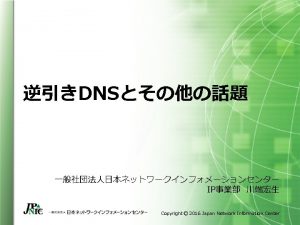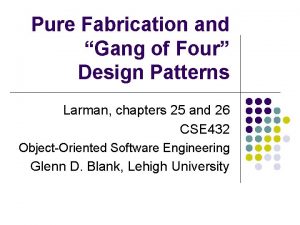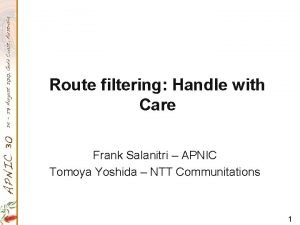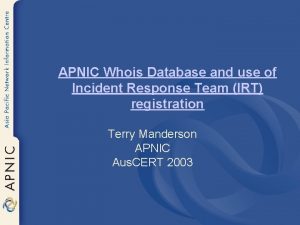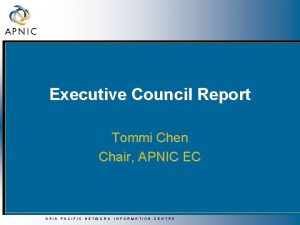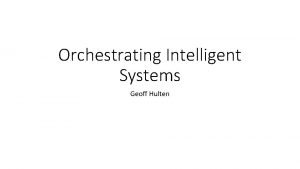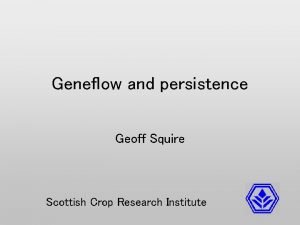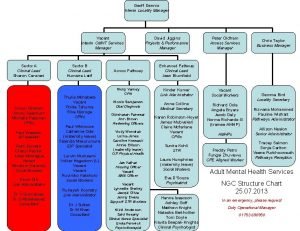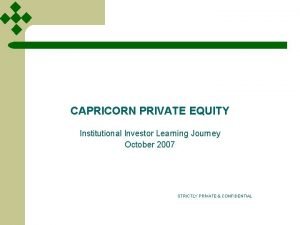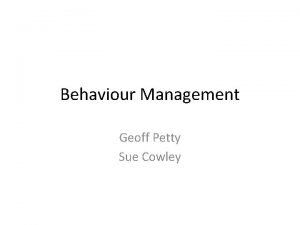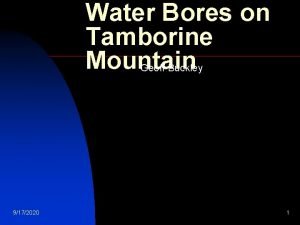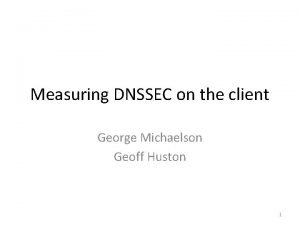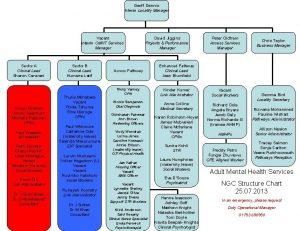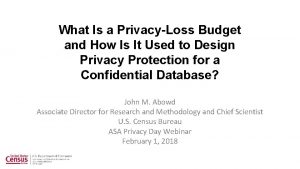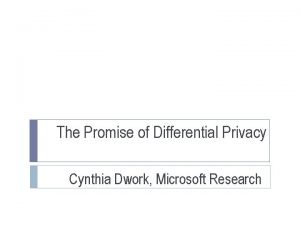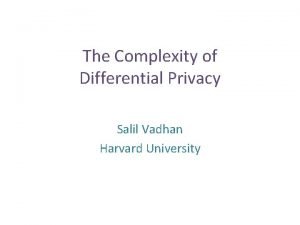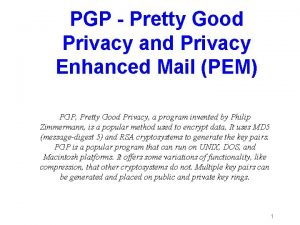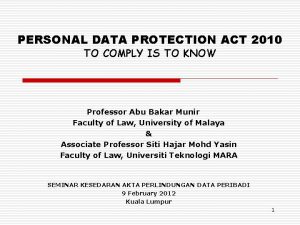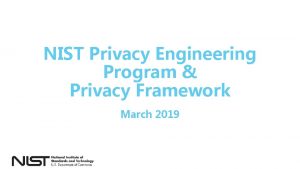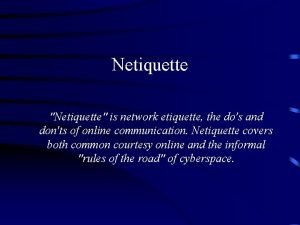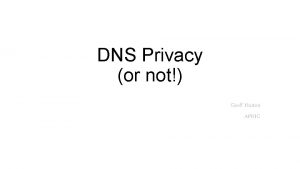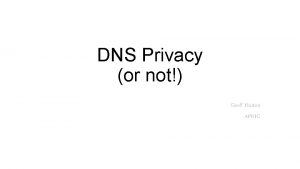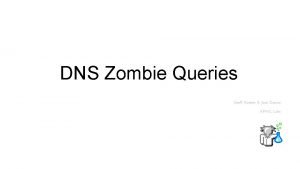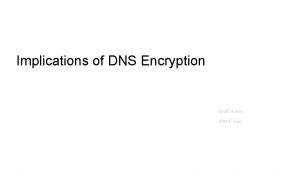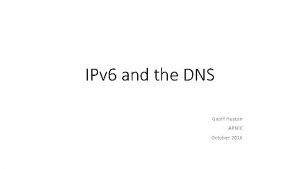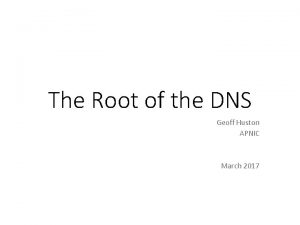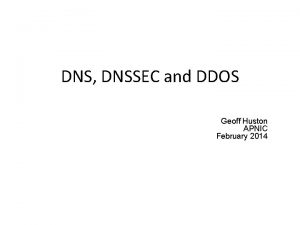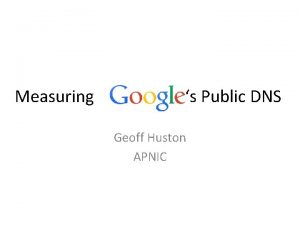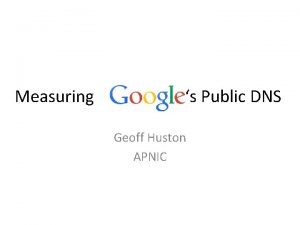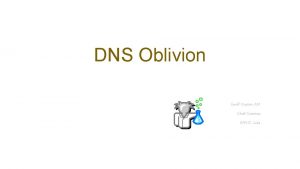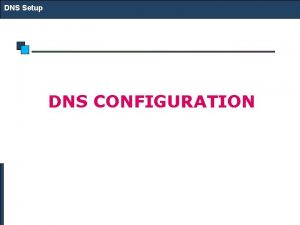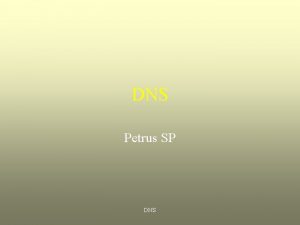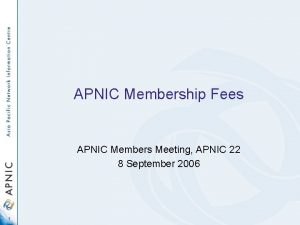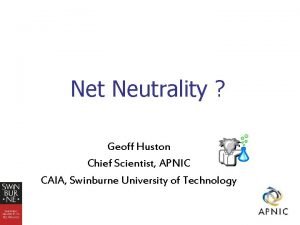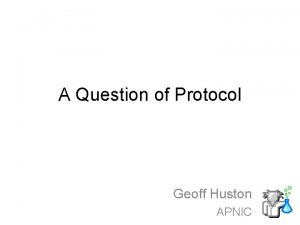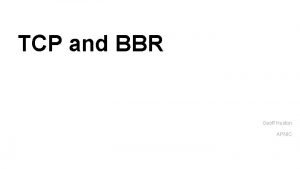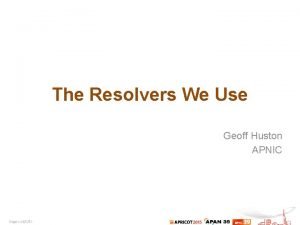DNS Privacy or not Geoff Huston APNIC https




















































- Slides: 52

DNS Privacy (or not!) Geoff Huston APNIC

https: //xkcd. com/1361/

Why? • Because everything you do on the net starts with a call to the DNS • If we could see your stream of queries in real time we could assemble a detailed profile of you and interests and activities • Do we have any evidence of DNS data mining? • Data miners don’t disclose their sources as a rule

Why? • Because everything you do on the net starts with a call to the DNS • If we could see your stream of queries in real time we could assemble a detailed profile of you and interests and activities • Do we have any evidence of DNS data mining? • Data miners don’t disclose their sources as a rule • How about something related: • Do we have any evidence of DNS stalking?

What if… • I gave you an absolutely unique name to resolve: • The name never existed before now • The name will never be used again • The name includes the time when the name was created • If I am the authoritative server for the name’s zone then I should see your efforts to resolve the name • Then I should never see the name as a resolution query ever again Unless you have attracted a digital stalker who performs re-queries of your DNS names!


DNS Re-query Rate • Over the past 30 days, some 5. 3% of users have some kind of DNS stalker that is asking the same query more than 30 seconds after the initial query • Only some of these could be explained by incredibly slow DNS resolver systems Daily Counts Daily Ratios

DNS Stalking • There are two kinds of DNS stalkers • Rapid tracking stalkers that appear to track users in real time • Bulk replay stalkers that replay DNS queries at a very high rate in bursts

DNS Stalking Age DNS Stalking uses both really recent data and more than year-old data!

DNS Surveillance • The DNS appears to be used by many actors as a means of looking at what we do online and censoring what services we can access online

DNS Surveillance • The DNS appears to be used by many actors as a means of looking at what we do online and censoring what services we can access online • Can we stop DNS surveillance completely? • Probably not! • Can we make it harder to collect individual profiles of activity? • Well, yes • And that’s what I want to talk about today

The DNS Privacy Issue • Lots of actors get to see what I do in the DNS • • • My platform My ISP’s recursive resolver Their forwarding resolver, if they have one Authoritative Name servers Snoopers on the wire • Can we make it harder for these “others” to snoop on me?

How we might think the DNS works Client DNS Resolver DNS Server

What we suspect the DNS is like Client DNS Resolver DNS Server DNS Resolver DNS Resolver DNS Resolver

What we suspect the DNS is like Client DNS Resolver Corrupted host platforms Wireline and middleware Inspection and interception Resolvers that leak queries DNS Servers that leak queries DNS Resolver DNS Resolver DNS Resolver

Why pick on the DNS? • The DNS is very easy to tap • Its open and unencrypted • DNS traffic is easy to tamper with • Its payload is not secured and tampering cannot be detected • Its predictable and false answers can be readily inserted • The DNS is hard to trace • Noone knows exactly where their queries go • Noone can know precisely where their answers come from

Second-hand DNS queries are a business opportunity these days

How can we improve DNS Privacy? • Lets look at a few behaviours of the DNS and see what we are doing to try and improve its privacy properties

The DNS is overly chatty The DNS uses the full query name to discover the identity of the name servers for the query name Hi root server, I want to resolve www. example. com Not me – try asking the servers for. com

The DNS is overly chatty The DNS uses the full query name to discover the identity of the name servers for the query name Hi root server, I want to resolve www. example. com Not me – try asking the servers for. com Hi. com server, I want to resolve www. example. com Not me – try asking the servers for example. com

The DNS is overly chatty The DNS uses the full query name to discover the identity of the name servers for the query name Hi root server, I want to resolve www. example. com Not me – try asking the servers for. com Hi. com server, I want to resolve www. example. com Not me – try asking the servers for example. com Hi example. com server, I want to resolve www. example. com Sure – its 93. 184. 216. 34

The DNS is overly chatty The DNS uses the full query name to discover the identity of the name servers for the query name Why are we telling root servers all our DNS secrets? In our example case, both a root server and a. com server now know that I am attempting to resolve the name www. example. com Maybe I don’t want them to know this

The DNS is overly chatty Is there an alternative approach to name server discovery that strips the query name in iterative search for a zone’s servers? Yes – the extra information was inserted into the query to make the protocol simpler and slightly more efficient in some cases But we can alter query behaviour to only expose as much as is necessary to the folk who need to know in order to answer the query

QNAME Minimisation • A resolver technique intended to improve DNS privacy where a DNS resolver no longer sends the entire original query name to the upstream name server • Described in RFC 7816

Example of QNAME Minimisation Ask the authoritative server for a zone for the NS records of the next zone: Hi Root server, I want to know the nameservers for com Sure, here are the servers for. com

Example of QNAME Minimisation Ask the authoritative server for a zone for the NS records of the next zone: Hi Root server, I want to know the nameservers for com Sure, here are the servers for. com Hi. com server, I want to know the nameservers for example. com Sure, here are the servers for example. com

Example of QNAME Minimisation Ask the authoritative server for a zone for the NS records of the next zone: Hi Root server, I want to know the nameservers for com Sure, here are the servers for. com Hi. com server, I want to know the nameservers for example. com Sure, here are the servers for example. com Hi example. com server, I want to resolve www. example. com Sure – its 93. 184. 216. 34

Interception and Rewriting • The DNS is an easy target for the imposition of control over access • Try asking for www. thepiratebay. org in Australia • Try asking for www. facebook. com in China • Etc etc • These days interception systems typically offer an incorrect response • How can you tell is the answer that the DNS gives you is the genuine answer or not?

DNSSEC • DNSSEC is defined in RFCs 4033, 4034 & 4035 • Adds a number of new RRtypes that allow a digital signature to be attached to RRsets in a zone and to define how keys that are used to generate signatures are also stored in the zone • DNSSEC validation of the DNS response can tell you if the response is genuine or if it is out of date or has been altered • DNSSEC can’t tell you what the “good” answer is, just that the answer you got was not it! • DNSSEC will also tell if is an NXDOMAIN response is authentic

DNSSEC and Recursive Resolvers • A DNS response that has been modified will fail to validate. When: • a client asks a security-aware resolver to resolve a name, and • sets the EDNS(0) DNSSEC OK bit, and • the zone is DNSSEC-signed then the recursive resolver will only return a RRset for the query if it can validate the response using the attached digital signature It will set the AD bit in the resolver response to indicate validation success Otherwise it will return SERVFAIL • But SERVFAIL is not the same as “I smell tampering” • Its ”nope, I failed. Try another resolver”

DNSSEC and Recursive Resolvers • If you are going to use a DNSSEC-validating recursive resolver • Such as 1. 1, 8. 8, 9. 9 or any other validating open resolver • Then make sure that all your resolvers perform DNSSEC validation if you don’t want to be mislead • Because SERVFAIL from a validating resolver means “try the next resolver in your resolver list”

DNSSEC in Spain

DNSSEC in Spain

DNSSEC in Portugal

Negative Chattiness • Names that do not exist in the DNS are also passed to the authoritative servers in order to return the NXDOMAIN response • Sometimes the questions we ask are informative, whether or not the DNS gives an answer

Aggressive NSEC Caching • Described in RFC 8198 • When a zone is DNSSEC-signed an authoritative server will answer a query for a non-existent name with an authenticated denial of existence response (NSEC or NSEC 3) • These records describe two adjacent labels in the zone that span the non-existent record • If recursive resolvers cache the NSEC span record then they can answer subsequent queries for any label within the span without passing the specific query onward for the cache lifetime of the NSEC record

Aggressive NSEC caching • It’s a tool for recursive resolvers • Stops queries for non-existent names always heading to the zone authoritative servers • Improves the efficiency of the resolver’s cache

Middleware and Wire. Tapping • Protecting the content of DNS responses is part of what we need to make the DNS more robust • If we want to prevent DNS inspection we also should look at encrypting the transport used by DNS queries and responses • Today the standard tool is TLS, which uses dynamically generated session keys to encrypt all traffic between two parties • We could use TLS between the end client and the client’s recursive resolver • It’s more challenging to use encryption between recursive resolvers and authoritative servers

DNS over DTLS • DTLS is a UDP variant of TLS that is intended to work over UDP rather than TCP (RFC 8094) • However: • DTLS is intolerant of fragmentation • It appears to have similar overheads to TLS • I’m not sure if there any implementations of DNS over DTLS

DNS over TLS • TLS is a TCP ‘overlay’ that adds server authentication and session encryption to TCP • TLS uses an initial handshake to allow a client to: • Validate the identity of the server • Negotiate a session key to be used in all subsequent packets in the TCP session • RFC 7858, RFC 8310 TLS 1. 2 handshake

DNS over TLS • Similar to DNS over TCP: • Open a TLS session with a recursive resolver • Pass the DNS query using DNS wireline format • Wait for the response • Can use held DNS sessions to allow the TLS session to be used for multiple DNS queries • The queries and the responses are hidden from intermediaries • The client validates the recursive resolver’s identity

DNS over TLS and Android https: //android-developers. googleblog. com/2018/04/dns-over-tls-support-in-android-p. html

DNS over TLS • Will generate a higher recursive resolver memory load as each client may have a held state with one or more recursive resolvers • The TCP session state is on port 853 • DNS over TLS can be readily blocked by middleware • The privacy is relative, as the recursive resolver still knows all your DNS queries • Supported by Bind (stunnel), Unbound, DNSDist

DNS over QUIC • QUIC is a transport protocol originally developed by Google and passed over to the IETF for standardised profile development • QUIC uses a thin UDP shim and an encrypted payload • The payload is divided into a TCP-like transport header and a payload • The essential difference between DOT and DOQ is the deliberate hiding of the transport protocol from network middleware with the use of QUIC • No known implementations of DNS over QUIC exist, though IETF work continues draft-huitema-quic-dnsoquic-05 DOT DOQ DNS TLS QUIC TCP UDP IP IP

DNS over HTTPS • Uses an HTTPS session with a resolver • Similar to DNS over TLS, but with HTTP object semantics • Uses TCP port 443, so can be masked within other HTTPS traffic • Can use DNS wireformat or JSON format DNS payload

DNS within the Browser • Firefox’s “Trusted Recursive Resolver” • Avoids using the local DNS resolver library and local DNS infrastructure • Has the browser sending its DNS queries directly to a trusted resolver over HTTPS • Servers available from Cloudflare, Google, Cleanbrowsing

Push DNS • HTTPS allows server push objects as well as pull/get methods • This can allow a web page to push a DNS result to the client without the client performing a query • There is no need for these DNS names to be separately defined by conventional DNS queries • Raises possibilities for segmented namespaces

DIY DNS • Run your own resolver • The issue here is limited opportunity for caching, which means that performance could be painful! • Run your own validating stub resolver • Getdns API interface • Stubby stub resolver • Still need to select a recursive resolver, but allows the local resolver to perform its own DNSSEC validation

EDNS(0) Client Subnet • There is a current debate between CDN operators that rely on customized DNS responses to perform content steering, and the use of large scale open resolvers that so not necessarily preserve locality • The result is that the CDN operators wanted the client’s subnet embedded in the query to ensure that the CDN could provide enhanced content steering for the client • This has raised a number of concerns about DNS privacy • There is a forming consensus that Client Subnet has been a step too far in terms of potential privacy leakage into the DNS

Choose your resolver carefully • The careful choice of an open recursive resolver and an encrypted DNS session will go a long way along the path of DNS privacy • But the compromise is that you are sharing your activity profile with the recursive resolver operator

My (current) DNS Config I use DNS over HTTPS • I have configured Cloudflare’s Cloudflared * to listen of localhost: 53 • I have set up my local /etc/resolv. conf to contain 127. 0. 0. 1 • All my DNS queries leave my laptop in an HTTPS port 443 stream towards 1. 1 * https: //developers. cloudflare. com/1. 1/dns-over-https/cloudflared-proxy/

Thanks!
 Geoff huston apnic
Geoff huston apnic Apnic dns
Apnic dns Privacy awareness and hipaa awareness training cvs
Privacy awareness and hipaa awareness training cvs Pure fabrication in grasp example
Pure fabrication in grasp example Ballad of booker t poem
Ballad of booker t poem Debogon project
Debogon project Myapnic
Myapnic Animal anthony apnic
Animal anthony apnic Apnic whois
Apnic whois Apnic ec
Apnic ec Vocab level d unit 3
Vocab level d unit 3 Watchdog dad
Watchdog dad Icedip
Icedip Geoff hulten
Geoff hulten Geoff hollington
Geoff hollington Geoff squire
Geoff squire Geoff savage
Geoff savage Geoff wilson lexington ky
Geoff wilson lexington ky Geoff dennis
Geoff dennis Geoff baines
Geoff baines Geoff sussman wound clinic
Geoff sussman wound clinic Geoff parks
Geoff parks Geoff layer
Geoff layer Capricorn private equity
Capricorn private equity Sue cowley behaviour management
Sue cowley behaviour management Geoff hayward
Geoff hayward Geoff goldsmith
Geoff goldsmith Geoff mason
Geoff mason Geoff bridgman nz
Geoff bridgman nz Geoff knowles
Geoff knowles Geoff kleinman
Geoff kleinman Geoff mitchell md
Geoff mitchell md Geoff cundiff
Geoff cundiff Geoff buckley
Geoff buckley Romiette and julio quotes
Romiette and julio quotes Geoff michaelson
Geoff michaelson Geoff willis
Geoff willis Geoff dennis
Geoff dennis Geoff petty
Geoff petty Geoff barton dundee
Geoff barton dundee Geoff barton headteacher
Geoff barton headteacher Privacy loss budget
Privacy loss budget Army privacy office
Army privacy office Alexander v heise
Alexander v heise Cynthia dwork differential privacy
Cynthia dwork differential privacy The complexity of differential privacy
The complexity of differential privacy Standard 7 privacy and dignity
Standard 7 privacy and dignity Contingent contracts
Contingent contracts How pgp works
How pgp works Malaysia data privacy law
Malaysia data privacy law Privacy engineering framework
Privacy engineering framework Benefits of netiquette
Benefits of netiquette Microsoft azure security privacy and compliance
Microsoft azure security privacy and compliance

